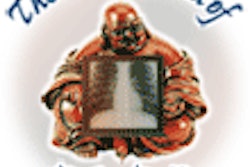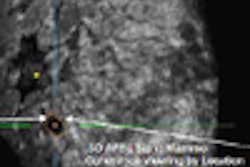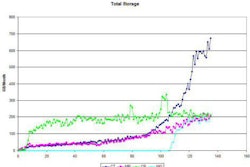A Canadian study to evaluate suitable compression ratios for imaging studies has found a broad degree of success in applying lossy compression schemes. Many of the radiologists participating in the study said they saw no discernable difference in image quality between images compressed with lossy and lossless methods -- although some modalities fared better than others.
"For most of the cases, (in) the mean levels of compression tested … there was no significant loss of information," said Dr. David Koff of the Sunnybrook Health Sciences Centre in Toronto. "We definitely recommend the use of lossy compression."
Koff presented the research at the annual meeting of the Society for Imaging Informatics in Medicine (SIIM) in Providence in June.
Continuing its recent research activities on irreversible compression, the Canadian Association of Radiologists (CAR) -- assisted by Fraser Health Authority and Canada Health Infoway -- recently conducted a clinical evaluation to assess the most appropriate compression ratios for JPEG and JPEG 2000. The results of the research, now in its final stages, will soon be presented to the CAR steering committee with recommendations for adoption, according to Koff.
More than 100 readers in total from all across Canada participated in the project, reading the images on the DICOM-compliant, calibrated workstations they use in their daily activity, Koff said.
Five modalities (computed radiography/digital radiography, CT, ultrasound, MR, and nuclear medicine) and seven radiological areas (angio, body, breast, chest, musculoskeletal, neuro, and pediatrics) were studied. All images were compressed in JPEG and JPEG 2000 (PICTools, Pegasus Imaging, Tampa, FL) at three different ratios:
- CR/DR: 20:1, 25:1, and 30:1
- CT: 10:1, 12:1, and 15:1
- Ultrasound: 8:1, 10:1, and 12:1
- MR: 16:1, 20:1, and 24:1
- Nuclear medicine: 7:1, 9:1, and 12:1
- Angiography: 8:1, 12:1, and 16:1
Each reader received a CD with 70 images, or an image stack of no more than 20 images for a CT scan. Answers were filled out online, when possible, and directly transferred to the researchers' server.
The study evaluated diagnostic accuracy using receiver operating characteristic (ROC) analysis and image comparison using an original-revealed forced-choice method. To measure diagnostic accuracy, the researchers utilized a mix of normal images and cases with identified pathologies, at a ratio of four abnormal cases to one normal case. The images were presented as a full-screen image compressed in JPEG and JPEG 2000 at one of the three different compression ratios.
The images were randomized, and readers were not shown the same image twice under different compression levels or algorithms, according to Koff. Readers chose from a restricted list of pathologies from a drop-down menu.
Reviewers also had to specify which sector of the image in which they saw a pathology, and were asked to give a confidence rating from 1 (definite absence of lesion) to 5 (definite presence of lesion).
In the image comparison component of the evaluation, each compressed image was paired with the original. Observers were then asked to rate the image quality degradation on a scale of 1 (unacceptable) to 6 (no detectable difference).
Of the 23 reader sessions, only breast CR and pediatric CT have yet to be completed, Koff said. In 18 of the 21 anatomical regions/modalities studied, no differences were noted. Discrepancies were found, however, in body CT, musculoskeletal CR/DR, and neuro CT, according to Koff.
The researchers calculated diagnostic accuracy by comparing rater sensitivity across compression levels and types. Sensitivity was defined as the proportion of abnormal images correctly identified, while specificity was defined as the proportion of normal images correctly identified.
In body CT, statistical differences were found in sensitivity based on the type of compression, with JPEG found to be more sensitive on average (0.95 versus 0.91). As for musculoskeletal CR, the researchers discovered that JPEG was more sensitive than JPEG 2000 at 25:1 (0.91 versus 0.80) and at 30:1 (0.97 versus 0.85).
As for image comparison analysis, a significant difference was found for both body CT images and neuro CT images, with a greater proportion of readers choosing categories 1, 2, and 3 (unacceptable to intermediate) for JPEG 2000-compressed images. No other statistical differences were seen, Koff said.
At the lowest compression ratios, there was no significant difference between lossy JPEG and JPEG 2000, he said. More than 89% of all forced-choice responses were scored as having no detectable difference between the compressed and uncompressed image, with another 8% scored as having no loss of diagnostic information, according to Koff.
Following the compilation of final results in neuro CT and breast DR, the researchers will send their final report to CAR, Koff said.
"We are confident that lossy compression can be used at the ratios we recommend with no visible loss of information, and have good hope that CAR will agree to release the compression guidelines by the end of the year," Koff told AuntMinnie.com.
By Erik L. Ridley
AuntMinnie.com staff writer
August 14, 2007
Related Reading
Enhanced DICOM objects, compression help with MDCT, MR challenges, March 23, 2007
Lossy 3D JPEG 2000 compression useful for abdominal MDCT, February 23, 2007
Canadian radiologists pursue lossy compression research, February 16, 2006
Image compression method may make large mammo datasets more manageable, December 22, 2005
Lossy compression wins over Canadian radiologists, July 21, 2005
Copyright © 2007 AuntMinnie.com




















